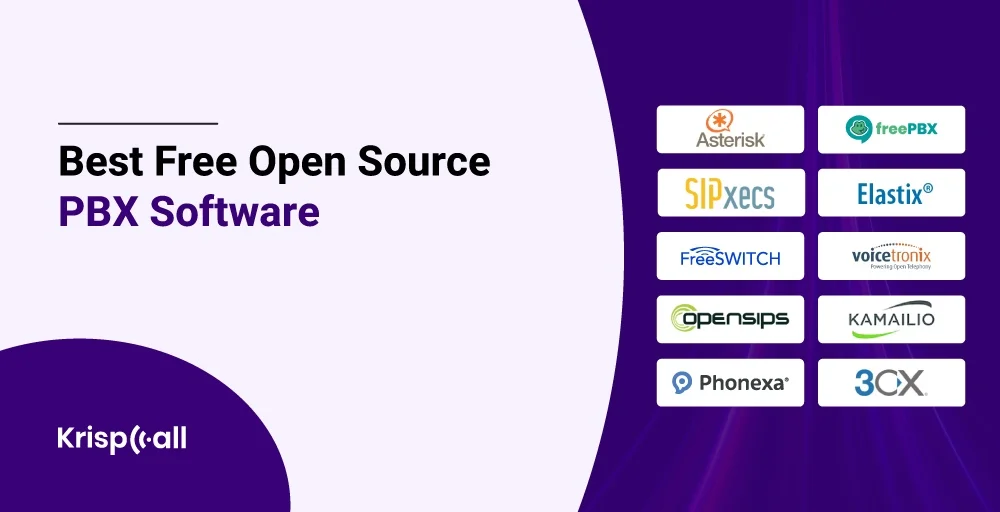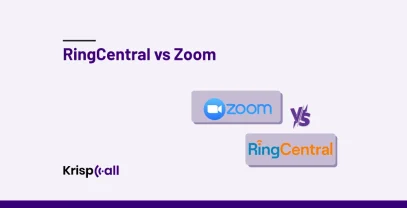Choosing the best and free open-source PBX software, at least in 2024, requires a lot of research, proper guidance, and a good understanding of the PBX software. 📚
During those processes, thousands of doubts may arise in your mind. Is it worth using? Is it really free or a scam? Which one to use? How they differ from each other, and many more. 🤔
Well, this blog will clear all your doubts and unlock your peace of mind. It will provide you with proper guidance on choosing the Best Free Open-Source PBX software for your personal or business use in terms of features, pros, and cons.
🔑 KEY HIGHLIGHTS
- Open-source PBX is software for your phone system aiding in enhancing your business communication, either internal or external, for free.
- Although Open-source PBX software offers free service, it requires technical expertise to maintain, update, and configure the system.
- The best free open-source PBX software are Asterisk, FreePBX, SIP Foundry, Elastix, FreeSWITCH, etc.
- Choosing the best free and open-source PBX software depends on various factors, including the features and functionalities that address businesses’ needs.
What is Open Source PBX?
Open Source PBX is a free software that offers a customizable and community-supported phone system for businesses to manage their internal and external communication needs. It provides a wide range of features, such as detailed call records, remote call answering, IVR, call blocking, and automated attendant.
Open-source PBX solutions are free but require technical expertise to update, maintain, and configure the system. They are feasible for businesses that want a customizable phone system and the flexibility to use their own SIP trunking provider. They also offer a wide range of custom features and integration at affordable costs.
How Does Open Source PBX Work?
Open source PBX works using open-source software to route calls. To run/work Open Source PBX, you need to install software on your computer, and some hardware may be required depending on your needs and requirements.
With their interface, you can make a call, transfer calls between devices, and set up call forwarding for the communication interaction.
Moreover, open-source PBX allows on-site or cloud-based solutions depending on the company’s structure and IT support. However, to achieve the best results, such a system requires technical knowledge to manage, including configuration, maintenance, and updating.
Benefits of Open Source PBX
Open Source PBX offers various benefits, from free customization to community support. Here is the breakdown of the benefits of Open Source PBX:
- Free to use: As the name suggests, Open Source PBX is free to use. You just need to download and install it on your computer. However, you still need some hardware to run it.
- Integration capability: It can be integrated with various applications, including email, CRM solutions, project management software, etc.
- Community support: The open-source community can be a wealth of information. You can get active support through wikis and forums.
- Interoperability: The Open-Source PBX solution can be used with VoIP endpoints, including ATAs, IP phones, and gateways, through SIP protocols and pre-defined standards.
- Works with SIP: Combining Open Source PBX Solution with SIP trunking provides efficiency in communications cost control.
Comparison of Top Free Open Source PBX Software
Here is the table of Open Source PBX comparison:
| Software | Pricing | Top Features | Best For |
| Asterisk | Free and open-source. For the paid plan: Start from $595/year | Voicemail, Call recording, IVR, SMS/text messaging and conference calling | Startups, SMBs, call centers |
| FreePBX | Free and open-source | CallerID, Unlimited IVRs, Call Flow Control, Paging, and Intercom | Asterisk-based VoIP business system |
| SIP Foundry | Free and open-source | Video conferencing, SIP Phone Support | Enterprise needing a feature-rich PBX system |
| Elastix | Free and open-source | Conference center with virtual rooms, Caller ID, Multiple trunk support, and Voicemail-to-Email Functionality | Businesses that require a scalable and flexible PBX |
| FreeSWITCH | Free and open-source | Dialplan, Clustering, Bypass/ Proxy Media, Video conferencing, and Event Socket Library | Enprises level businesses that require a flexible UC platform |
| OpenPBX by Voicetronix | Free and open-source | Click-to-dial, Call Transfer, Music on hold, Integrated CRM, and Call record visibility | For small to mid-sized business |
| OpenSIPS | Free and open-source | SRV DNS support, IP Blacklist, ENUM Support, stateless and transactional stateful SIP Proxy Processing | For corporations and call centers. |
| Kamailio | Free and open-source | WebRTC support, instant messaging, Volte and IMS extension, NoSQL and SQL Backends, SIP Registrar, Proxy and Redirect Server | Businesses who want to create large telephone networks. |
| Phonexa | Free and open-source For the paid plan: Start from $100/year | Predictive Dialing, Video Conferencing, Ping tree lead routing, and automated multi-message campaigns | Best suited for call centers or large agencies |
| 3CX | Free and open-source For the paid plan: Start from $175/year | Advanced IVR Call routing, unified communication, and call queuing | Larger companies that want to take total control over their PBX |
10 Best Free Open Source PBX Software
In the PBX technology landscape, many software solutions offer free and open-source PBX software that may fit your business needs.
Here is the list of the 10 best free open source PBX software:
1. Asterisk
Asterisk is a free and open-source software that allows a computer to function as a PBX, enabling VoIP and traditional phone service. It can be used to manage and route phone calls with an organization offering various features such as voicemail, IVR, and call queues.
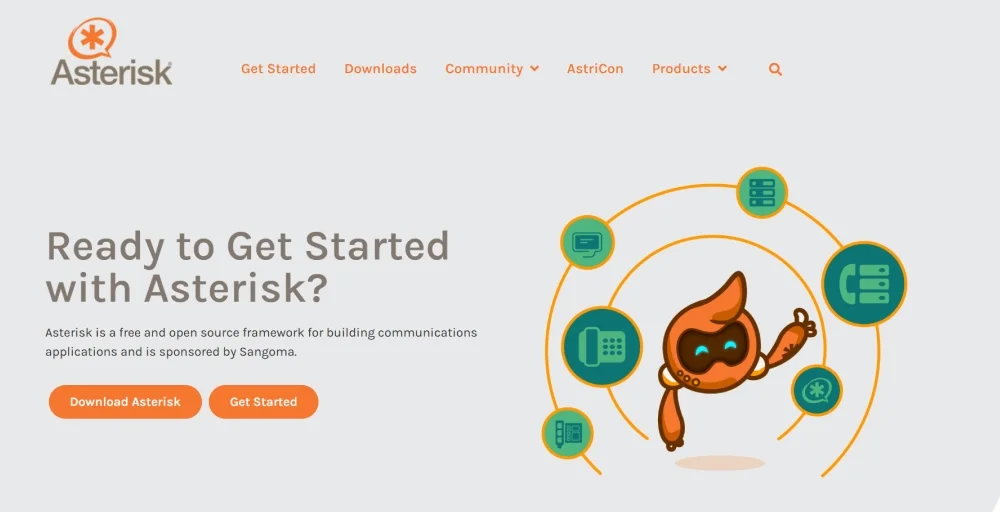
Asterisk can be highly scalable and customizable, supporting a wide range of telephony protocols. With Asterisk, users can modify and extend its functionality to meet their needs and requirements without paying any license fee.
Top Asterisk Features
- Call transfer, Queuing, and Recording
- Advanced Interactive Voice Response(IVR)
- Caller ID
- Voicemail
- SMS or Text Messaging
- Music On Hold
Asterisk Pros
- Open-Source and cost-effective
- Customizable and flexible
- Scalable
- Robust PBX functionality
- Interoperability
Asterisks Cons
- Requires Linux expertise
- No user friendly
- Complex dialplan
- Difficulty finding a certified professional
Best For
Asterisk Free Open Source PBX software best suits businesses looking for a cost-effective and customizable communication solution. Its scalability helps it adapt to any business size, from small startups to large enterprises. Its advanced features can be helpful to call centers and contact centers.
2. FreePBX
The web-based PBX software, FreePBX is an open-source software that offers comprehensive PBX tools that manage the Asterisk open-source communication server. It is completely free to download and use and offers flexibility to customize the needs and requirements.
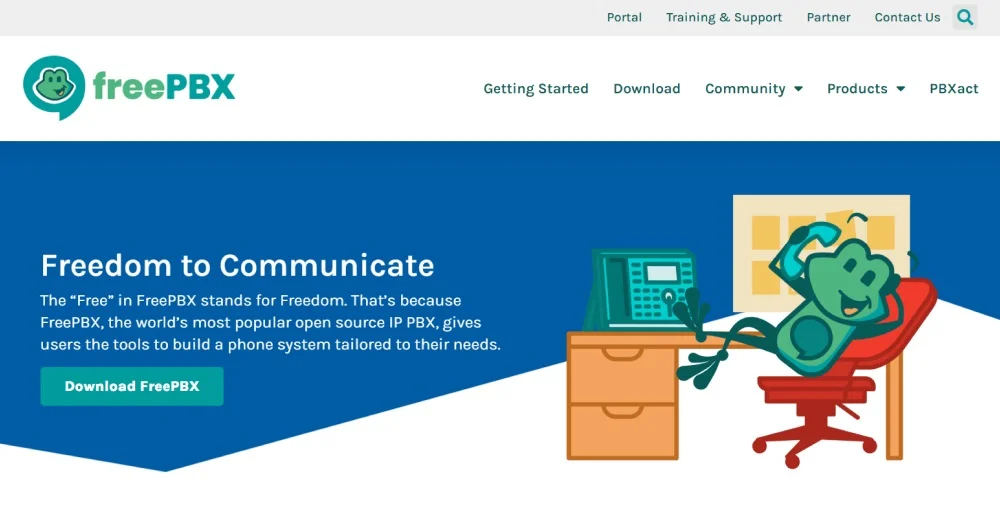
FreePBX provides a wide range of advanced features to build a scalable business phone system, including voicemail call recording, call routing, and more. Because of its active development community support, FreePBX remains a highly compatible and customizable platform.
Top FreePBX Features
- Unlimited Number Extension
- Caller-ID
- Unlimited IVR’s
- Call Flow Control
- Paging and Intercom
- Voicemail to email
FreePBX Pros
- Secure and reliable
- Impressive extensions and features
- Wide language support
- Scalable and flexible
- No license limitation
FreePBX Cons
- Complex installation process
- Security vulnerabilities
- Limited technical support
- Advanced features require additional cost
Best For
FreePBX is best suited for individuals and businesses searching for customizable solutions to manage Asterisk-based VoIP systems at an affordable cost. Its flexibility and scalability make it an ideal choice for businesses of any size, from small businesses to large enterprises.
3. SIP Foundry
SIP Foundry is another free and open-source PBX software with robust communication features, including video, chat, and voice functionalities. It can be a competitive option for a business that requires versatile and secure PBX solutions, as it provides scalability and customization with a wide range of functionalities.

SIPfoundry is also known for building the SipX project, which is a comprehensive SIP PBX software for the Linux Operating System. They aim to provide a full-featured open-source solution for free.
Top SIP Foundry Features
- Video conferencing
- Contact center PBX server
- SIP phone support
- Secure platform
- Advanced call routing
- On-premise or cloud deployment
SIP Foundry Pros
- Flexible configuration
- Support for multiple protocols
- Real-time reporting
- Community support
- Cost-effective
SIP Foundry Cons
- Complex installation
- Limited customization
- Requires technical understanding
- Additional hardware costs
Best For
Open-source PBX SIPfoundry is best suited for businesses that require video conferencing capabilities, a robust chat support system, and advanced call-handling features. It is a versatile and scalable solution for businesses of any size, as it supports multiple channels, including video and voice abilities.
4. Elastix
Elastix is a free and open-source that provides a variety of communication services, including electronic mail, calling, teleconference, fax, and instant messaging among team members.
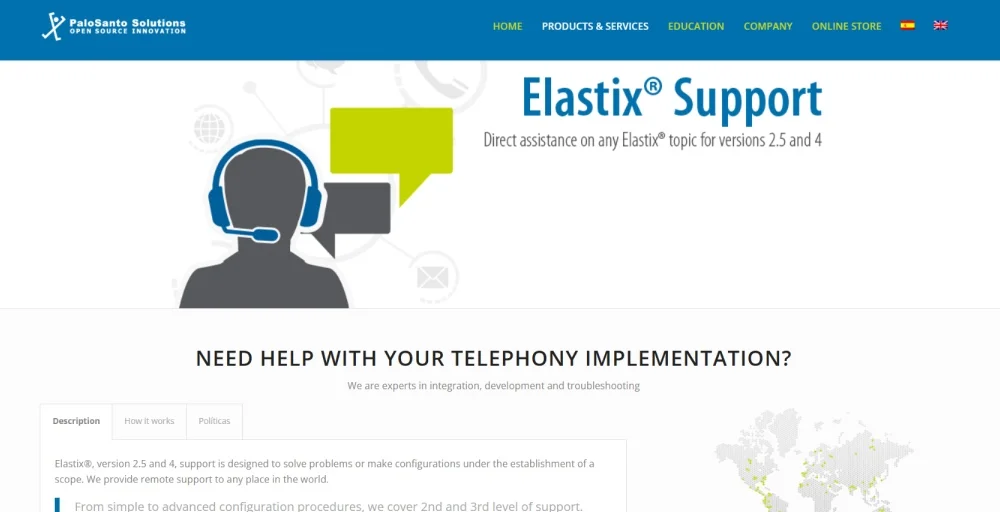
Elastix was first released in 2006 year by a company named Palo Santo Solutions in Ecuador. Elastix open-source PBX is based on CentOS distribution, which is a type of Linux Operating System that makes it compatible with more similar systems.
Elastix Top Features
- Conference center with virtual rooms
- SIP and IAX support
- Voicemail-to-Email functionality
- Caller ID
- Multiple trunk support
- Call parking and recording
Elastix Pros
- Feature-Rich
- Third-party integration
- Offer Video conferencing
- Distributed workforce support
Elastix Cons
- Limited customer support
- Complex configuration
- Expensive setup
- Limited mobile support
- Licensing fee
Best For
Elastix can be best suited for SMEs, startups, businesses, and governments that require secure, scalable, and sophisticated communication systems.
5. FreeSWITCH
The versatile and scalable multi-platform open-source PBX software, called FreeSWITCH, supports a wide range of protocols and provides robust features. Due to its scalability, it can easily handle thousands of simultaneous calls.
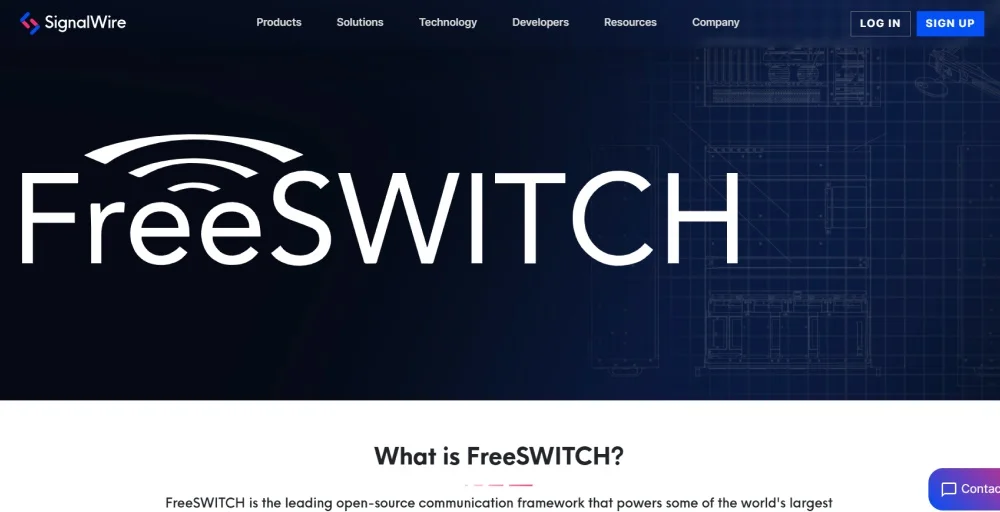
FreeSWITCH provides impressive features, including soft conferencing, sync audio, an event/logger engine, interactive voice response, and real-time capabilities. Its modularity and extensible architecture nature enable developers to customize features based on their requirements.
FreeSWITCH Top Features
- Event socket library
- Dialplan
- Clustering
- Bypass / Proxy Media
- Voicemail with MWI
- Video conferencing
FreeSWITCH Pros
- Efficient resource utilization
- Clustering capabilities
- Modular architecture
- Multi-tenant support
- Improved IVR
FreeSWITCH Cons
- Configuration complexity
- Limited end device templates
- High potential system cost
- High server footprint
Best For
FreeSWITCH open-source PBX is best suited for businesses that want to acquire a customizability and scalability nature in the industry. Their advanced features with customization control can be suitable for large enterprises.
6. OpenPBX by Voicetronix
OpenPBX by Voicetronix is an open-source phone system management tool developed by Voicetronix. It offers businesses a web-based tool that can be easily configured and integrated with various communication systems with a simplified web-based administration interface.
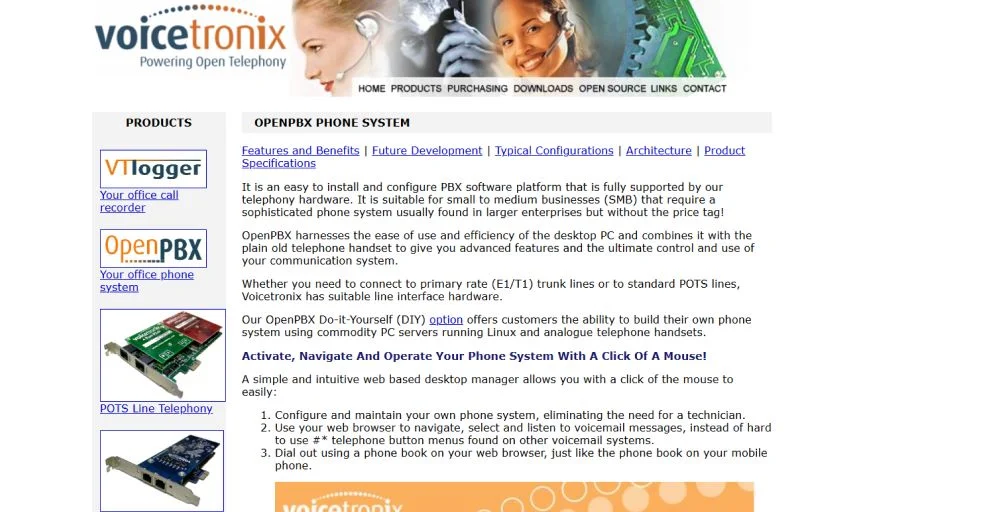
Voicetronix is recently been working on adding SIP module support to the next generation of OpenPBX. Adding module support helps in expanding its capabilities to employ both IP telephony services and traditional fixed-line.
OpenPBX Top Features
- Call record visibility
- Integrated CRM
- Music on hold
- Voicemail to email
- Click-to-Dial
- Call transfer
OpenPBX Pros
- Web-Enabled platform
- Standard PBX features
- DIY option
- Customization and flexibility
- Ongoing development and support
OpenPBX Cons
- Limited information
- Lack of detailed reviews
- Reliance on Voicetronix hardware
- Potential compatibility issues
Best For
OpenPBX, open-source software by Voicetronix, is best suited for small—to mid-sized businesses. It offers a sophisticated phone service with a wide range of advanced features at an affordable cost.
7. OpenSIPS
The OpenSIPS software is an SIP proxy and server that offers a wide range of features for communication solutions to build a robust PBX system. Their extensive features include call forwarding, call distribution, support for voicemail, IVR prompts, caller ID, and a comprehensive call center module.
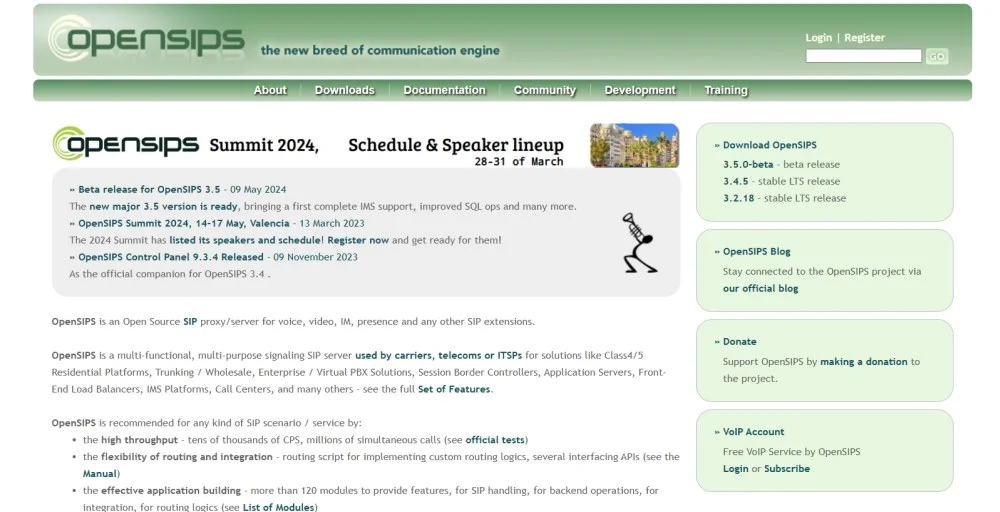
OpenSIPS can be integrated with other components, such as recorders, media servers, and billing systems, leveraging Asterisk PBX to offer the missing functionalities. The features include IVR, voicemail, and other advanced call-handling features.
OpenSIPS Top Features
- IP blacklist
- SRV DNS failover
- ENUM support
- Robust and performant SIP (RFC3261) Registrar server, Location server, Proxy server, and Redirect server
- Stateless and transactional stateful SIP Proxy processing
- Dialog support (call monitoring, call termination from the proxy side, call profiling)
OpenSIPS Pros
- Scalability
- Stateless and transactional SIP processing
- IPv4 and IPv6 support
- Support for replication
- Least cost routing
OpenSIPS Cons
- Steep learning curve
- Limited support for IVR and voice recognition
- Limited support for TTS
- Limited support for load balancing
Best For
OpenSIPS is best for developing scalable phone systems for companies, corporations, and call centers. It is very versatile and has many unique features appropriate for these sorts of projects.
8. Kamailio
Kamailio is an open-source SIP server that executes phone calls over the Internet. This application has been designed to handle a large volume of concurrent call traffic and is fast.
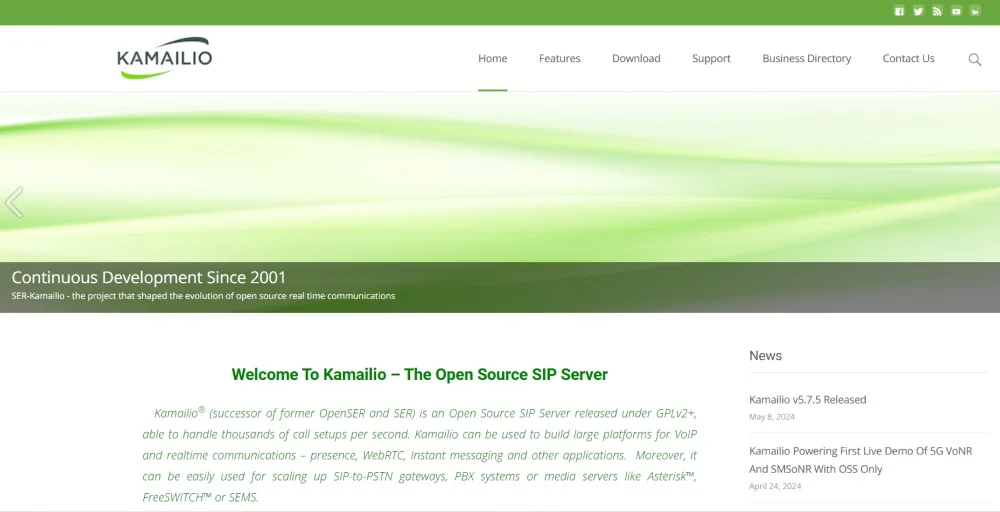
Kamailio is used to build massive communication solutions in real-time and provides typical elements such as presence, WebRTC, and instant messaging.
Kamailio Top Features
- WebRTC support
- Instant messaging
- SIP Registrar, Proxy, and Redirect server
- RADIUS and Syslog accounting and authorization
- NoSQL and SQL backends
- VoLTE and IMS extension
Kamailio Pros
- Scalability
- Ease of extensibility
- Deployment option
- Prompt updates
- Cost-effectiveness
Kamailio Cons
- Potential performance limitations
- Steep learning curve
- Limited support for advanced features
- Limited customization
Best For
Kamailio is best for those who want to create large telephone networks that run through the web. It provides presence tracking, text messaging, and video conferencing features. It also integrates easily with other phone solutions such as the Asterisk and FreeSWITCH.
9. Phonexa
Phonexa software offers high-quality cloud-based communication tools to help businesses track and improve their phone calls. With Phonexa, you can record and analyze calls and score agent performance to track their productivity.
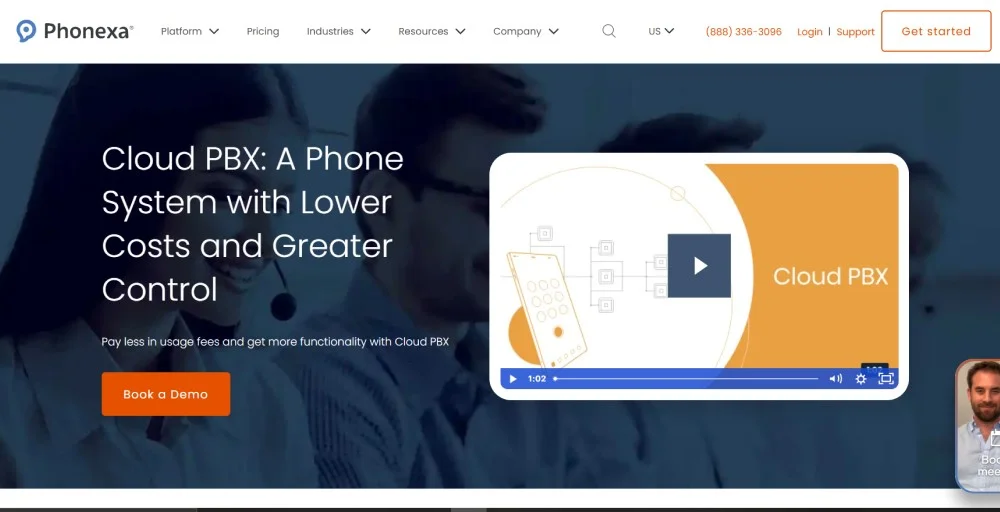
Using Phonexa PBX can be valuable for those businesses that require virtual PBX to connect with consumers by phone. It provides flexible solutions for multiple industries, including home service, financial service, healthcare, and insurance at an affordable cost.
Phonexa Top Features
- Predictive dialing
- Video conferencing
- Extensive reporting and analytics
- Ping tree lead routing
- Automated Multi-Message campaigns
- Call recording and operator scoring
Phonexa Pros
- Centralized database and phone book
- Comprehensive marketing support
- Seamless integration with other
- Fax integration
- Continuous feature updates
Phonexa Cons
- Complexity for small businesses
- Potential performance issues
- Limited customization options
- Lack of offline functionality
Best For
Phonexa is best suited for call centers or large agencies needing advanced call-handling features, including call analytics, call tracking, and marketing automation. Its robust features offer a comprehensive platform to generate leads and conversions.
10. 3CX
3CX PBX software can greatly benefit the business phone management system that enables you to use the internet to make calls. It relies on SIP and enables one to make calls via the cloud or service provided by 3CX.
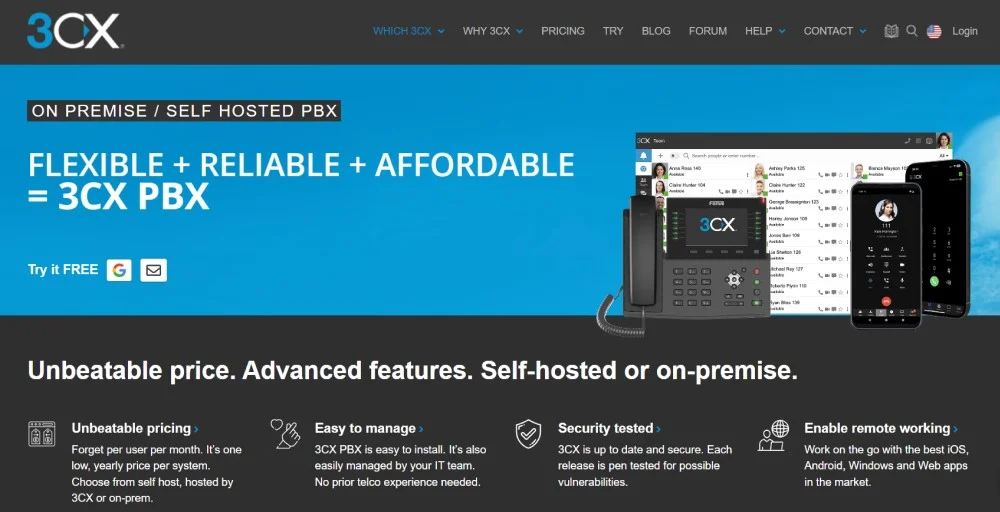
The 3CX PBX can run on Windows, Linux, and Raspberry Pi. It also supports VoIP services, SIP soft/handphones, faxing, voice, and web meetings, as well as traditional PSTN telephone lines.
3CX Top Features
- Advanced IVR
- Call routing
- Video conferencing
- Unified communication
- Call queuing
- Live chat
3CX Pros
- Customization
- Mobile integration
- Cost-effective
- Real-time monitoring
- Easy update
3CX Cons
- Limited reporting capabilities
- Available few call handling features
- Fewer virtualization options
- Available few call center features
Best For
3CX PBX is best suited for larger companies that need total control over their PBX and call center. It offers high security and customization to manage their PBX and call center system.
Conclusion
The Best free and open-source PBX software solution depends on various factors, including offered features and functionalities that address businesses’ needs. You may need to consider its size, how convenient its functionality is, and how flexible the tool is to use.
The 10 best free open-source PBX software include Asterisk, FreePBX, SIP Foundry, Elastix, FreeSWITCH, Kamailio, Phonexa, 3CX, and OpenPBX by Voicetronix.
From using Asterisk PBX to 3CX PBX, each PBX solution offers different functions and capabilities. It also provides feature customization options that can be tailored according to the business needs and requirements.
FAQ
Is Private Branch Exchange (PBX) hardware or software?
Private Branch Exchange (PBX) systems can be hardware or software. Traditional PBX systems are hardware-based and consist of physical equipment installed on-site at a business. These systems include phone lines, switches, and other telecommunication hardware necessary to manage calls within the company and to external lines.
Whereas modern PBX systems are often software-based. They run on standard servers or virtual machines and use VoIP (Voice over Internet Protocol) technology to manage calls.
Is PBX better than VoIP?
VoIP is better than PBX, as it can be used with PBX systems for communication protocol. VoIP provides more advanced features compared to traditional PBX systems. Also, they are more cost-effective and flexible than PBX systems.
What are the types of PBX?
There are several types of PBX (Private Branch Exchange) systems:
- IP PBX
- Traditional PBX
- Hosted PBX
- Hybrid PBX
- Virtual PBX
- Cloud-based PBX
- Managed PBX
- On-premise PBX
- SIP PBX
- Unified Communication PBX
Which is the best PBX system?
A hosted PBX system is the best PBX system. Some hosted PBX systems include 8×8, RingCentral, and GoToConnect,. To choose the best PBX system, you must consider certain factors, including security, integration capabilities, scalability, required features, ease of use, and customization options. You might need to ensure scalable, reliable, and feature-rich communication capabilities.

